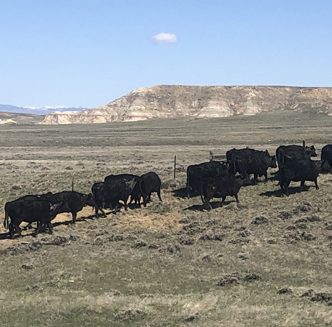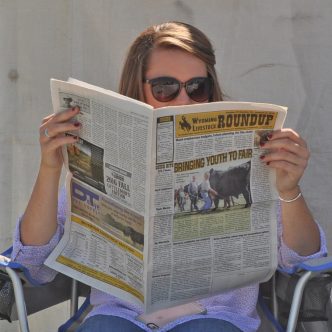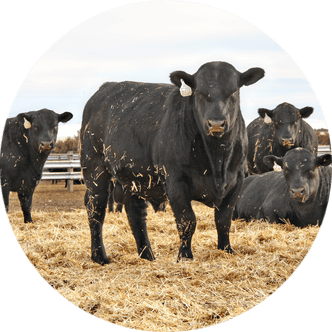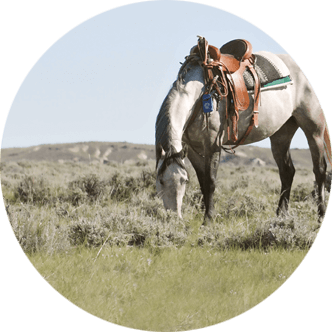LREC observes effectiveness of burros as livestock guardian animals
The University of Wyoming (UW) Extension Sheep Task Force held the first installment of its three-part Predator Management Webinar Mini Series on Feb. 25, where UW Laramie Research and Extension Center (LREC) personnel discussed the university’s use of burros as guardian animals in their sheep flock.
Moderated by UW Extension Program Assistant Dylan Laverell, the seminar featured LREC Director Dr. Derek Scasta, LREC Sheep Unit Manager Kalli Koepke and LREC Equine and Arena Manager Elias Hutchinson, who shared anecdotes and insights on what they have observed while implementing burros as tools to mitigate sheep predation on the university’s farm in southeast Wyoming.
Burro acquisition
To begin, Koepke explained the LREC Sheep Unit runs 450 head of Rambouillet ewes, seven breeding sires and a small flock of Katahdins on nearly 6,000 acres just outside of Laramie.
Flanked by the city limits to the north, the Laramie River to the south, the foothills of the Laramie Range to the east and the Snowy Range to the west, Koepke noted the LREC farm serves as a corridor for wildlife – including predators, particularly coyotes.
“It’s important to note we technically have three safe havens around us – the Laramie city limits, the airport to the north and the city monolith to the west. So, we get a lot of predator pressure every year because of these safe havens,” she said.
Like many Wyoming sheep operations, LREC has utilized the help of Great Pyrenees livestock guardian dogs (LGDs) to mitigate predation.
However, after inheriting a few Bureau of Land Management (BLM) mustangs originally purchased through a different university program, they began questioning the effectiveness of equine guardian animals.
Hutchinson remarked, “We decided to put the mustangs out with the sheep to see what happened, and we noticed they would always stay between the sheep and our high-pressure zones.”
From there, the idea to purchase BLM burros came about, and the sheep unit acquired four female burros from California – Rose, Sophia, Blanche and Dorothy.
Flock integration
The LREC crew then began integrating the California burros into the sheep flock, and with a lack of information available in research literature, they saw an opportunity to turn the task into a demonstration project.
Scasta explained the burros were split into four separate flocks and pastures and monitored daily for about 45 days. Distance between the burros and sheep was frequently estimated using a rangefinder and Google Earth to measure if they were “in, near or away from the flock.”
“The first burro, Rose, was immediately integrated into the flock, pretty much within 24 hours,” Scasta said. “This burro was placed in a 17-acre pasture with 102 mature ewes, which was the highest sheep density of all of the pasture combinations.”
“Importantly, there were no equine neighbors, with the exception of a donkey colleague across the road to the north,” he added.
This burro, known as Sophia, was placed in a 55-acre pasture with 105 yearling ewes.
Scasta noted Sophia exhibited strong social ties to Rose in the beginning, but after about two weeks, she stopped standing at the fence.
The third burro, Blanche, was placed in a 102-acre pasture with 114 yearlings and multiple equine neighbors, including 16 horses to the northeast and 15 more to the south.
“Two of the boundary fences had a lot of horses, and she just wanted to socialize,” explained Scasta. “We spent a lot of time intervening – hobbling her and pinning her with the sheep. After about a week, she figured out what was expected of her.”
Dorothy, the oldest burro of the bunch, was positioned in the most complex situation, according to Scasta. She was placed in 700-plus acres of brush, benches and willows bordered by the river. Dorothy’s bunch also had the lowest density with only 50 ewes.
“There were also multiple cross fences with open gates, several water points, a small group of cows and some equine neighbors to the east, which she was quite interested in,” Scasta said, further noting the area is also frequented by several ranch dogs.
“After 25 days, Dorothy hadn’t integrated into the flock at all,” he admitted. “We ended up moving her to a more ideal situation – an 18-acre meadow with 30 ewes and a ram – and within five days, she had integrated into the group.”
Ultimately, LREC observed all burros had integrated into their respective flocks within 35 days of introduction, and the qualitative data gathered showed burros were “in the flock” 90 percent of the time.
Scasta remarked, “Some people may argue it comes down to personality and individual variation, but I am going to argue it’s setting. It’s the size of the pasture and the complexity. The burros need to be set up for success.”
He added, “However, it’s also important to note, it was possible for us in every situation with some adjustments, some patience and some teamwork.”
Advantages and disadvantages
While the first phase of the project certainly allowed LREC to make some important observations, the paramount goal of acquiring burros was to reduce predation on UW’s sheep flock.
According to Koepke, although the farm still saw a lot of predator pressure, they measured a 50 percent reduction in sheep loss after integrating the burros.
The LREC crew also compiled information on the advantages and disadvantages of running burros as livestock guardian animals.
First, Scasta noted the purchase price of burros is generally pretty low compared to LGDs, and they often cost less in terms of veterinary and healthcare expenses.
“Burros are really suitable to existing fencing and feed resources,” he added. “They respect fences that contain sheep, unlike dogs which may slip under the wire and roam, and they eat the same forage as the sheep.”
Additionally, burros generally have a longer working life, require minimal supervision and have a fairly quick learning pace.
On the other hand, one of the biggest challenges the LREC team faced were equine neighbors since the burros naturally gravitated to their equine counterparts instead of the sheep they were supposed to bond with.
Koepke also noted she ran into a few challenges when it came to herding.
“They’re kind of easy to stress out, and they react to stress poorly,” she said. “When we first go out to herd, whether we are using dogs, horses or four-wheelers, the burros will do everything they can to create chaos, but it usually only lasts for a couple of minutes and then they figure it out. We’ve just had to learn to be patient with them.”
Because of their poor reaction to stress, Koepke also noted the LREC team had some issues when donkeys were gathered into tight barns or alleyways.
Koepke, Hutchinson and Scasta agreed running burros may require some prior equine knowledge and comfortability, as well as a good management strategy for keeping up on hoof health and body condition.
“We tried to use a pretty practical management style, so whenever we brought in the sheep – to swap rams, switch pastures, etc. – we would go ahead and trim their feet,” Hutchinson said.
To do this, burros were roped by their feet, stretched out and tied down quietly to reduce stress.
“In a typical management system, I would assume this procedure needs to be done no less than two times a year,” Hutchinson added. “When the BLM does this, they use a stanchion, and honestly, in a lot of cases, I think one could restrain them in a horse trailer to do it as well.”
Moving forward
Now that LREC’s burros have bonded to the sheep and proved beneficial in multiple capacities, Koepke said she is curious how they will fare as the team begins moving the flock around within production groups and across the landscape.
“We are also really curious about how they will work with lambs,” she acknowledged.
Although most literature recommends removing burros from the flock during lambing, LREC’s next experiment will examine how Rose, their gentlest burro, reacts to labor and fresh lambs.
“We’ve been thinking about all of the other opportunities there are to observe these burros in the future,” Koepke concluded.
Hannah Bugas is the managing editor of the Wyoming Livestock Roundup. Send comments on this article to roundup@wylr.net.





